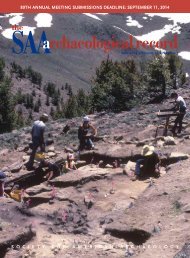SAA
Nov2016_web
Nov2016_web
You also want an ePaper? Increase the reach of your titles
YUMPU automatically turns print PDFs into web optimized ePapers that Google loves.
VIDEO GAMES AND ARCHAEOLOGY<br />
Figure 3. Screenshot from Apotheon. Image by AlienTrap Games (freely downloadable as wallpaper at http://www.apotheongame.com/).<br />
the opportunity to relate to these events and immerse themselves<br />
in the architecture and material culture of World War<br />
I, the development team not only did extensive archival<br />
research in collaboration with historians but also included<br />
the results of this research into the game as a collection of<br />
facts and artifacts that players can discover and browse.<br />
Archaeology has more to offer than an “authentic” experience<br />
of the past. It can also provide exciting, untapped<br />
themes or designs. For instance Apotheon, a platform<br />
released in 2015 by AlienTrap, is set in mythological ancient<br />
Greece (see Figure 3). The game borrows its design from the<br />
black figure pottery style (seventh–fifth century B.C.E.) of<br />
classical Greece. This creates the impression that one is playing<br />
a character as portrayed on an ancient Greek vase while<br />
moving through different mythological scenarios. Despite<br />
several chronological and/or mythological inaccuracies, the<br />
developers have created a beautiful setting based on ancient<br />
material culture, bringing the enjoyment of this style to a<br />
wider audience in a unique way. An interesting discussion<br />
piece by Gilles Roy (2015) analyzes the aspects that make this<br />
game interesting and compelling.<br />
Video games equally have a lot to offer to the field of archaeology,<br />
particularly in two core areas: public outreach and<br />
research. At a basic level, video games can introduce the concept<br />
of archaeology to the public by implementing archaeology<br />
as a gameplay mechanic. The immensely popular World<br />
of Warcraft by Blizzard Entertainment, for instance, has<br />
incorporated archaeology as an in-game profession. Even if it<br />
provides a simplified version of archaeological practice, it<br />
does introduce archaeology to a huge and global audience.<br />
Archaeological and heritage outreach has also been done<br />
extensively through the world-creating game Minecraft by<br />
Mojang. Here, archaeologists can learn from recent initiatives<br />
by museums that engage virtual and physical visitors<br />
through Minecraft projects. The Tate (2014) in the United<br />
Kingdom, for example, collaborated with artist Adam Clarke<br />
to virtually reconstruct not only the museum’s galleries but<br />
also the individual artworks. Players can enter the galleries<br />
and step into the paintings and works of art to explore the<br />
worlds behind the paintings. A similar project is currently<br />
being undertaken with the British Museum. 6 Together with<br />
the public, they aim to reconstruct the entire museum<br />
through a large-scale crowd-sourcing project. The VALUE<br />
group has explored the possibilities of using Minecraft for<br />
archaeological reconstructions, by running a crowd-sourced<br />
event aimed to collaboratively rebuild the recently destroyed<br />
Temple of Bel in Palmyra, Syria, for example. 7<br />
With regards to archaeological research, video games can be<br />
used as platforms for experimental archaeology. Colleen<br />
Morgan (2009), for instance, has rebuilt Çatalhöyük to investigate<br />
a number of topics. One of these concerned the reconstruction<br />
of ovens, which have been found extensively on the<br />
site (Morgan 2009:476). Morgan was able to experiment with<br />
these ovens and buildings in Second Life to test the effects of<br />
smoke on living conditions.<br />
14 The <strong>SAA</strong> Archaeological Record • November 2016




